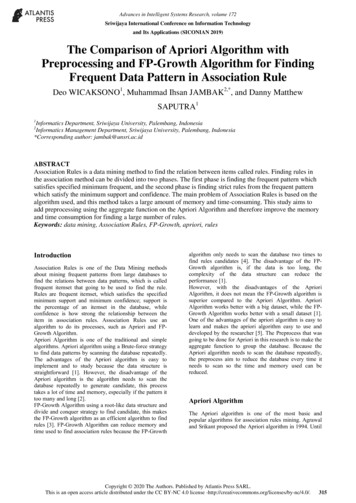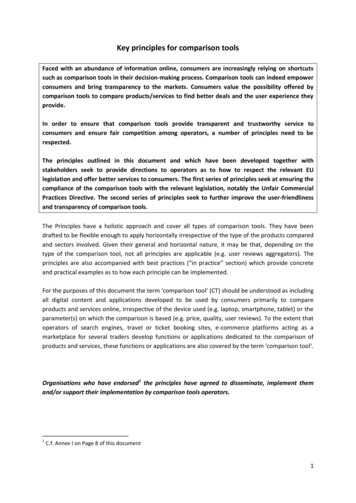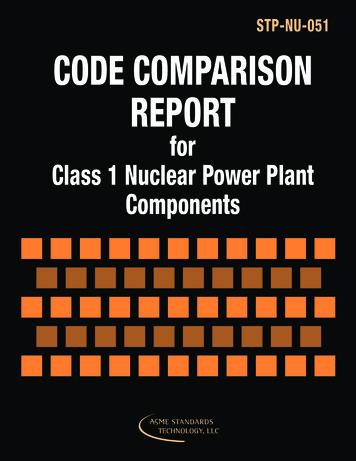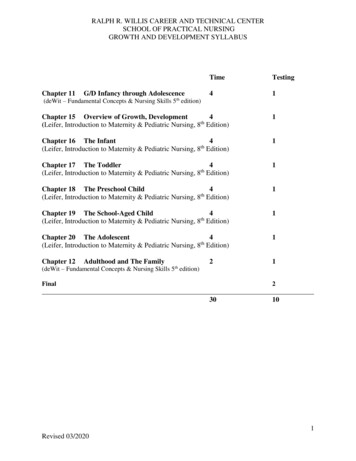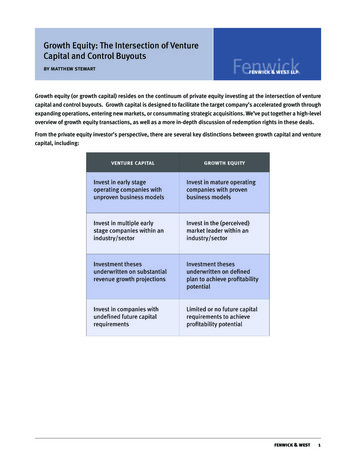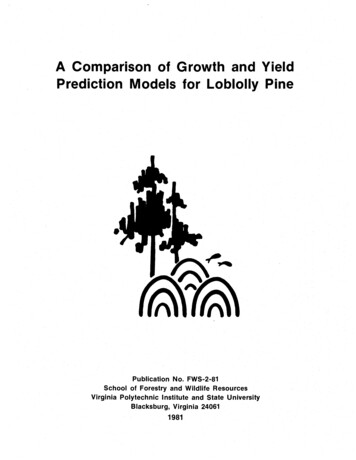
Transcription
A Comparison of Growth and YieldPrediction Models for Loblolly PinePublication No. FWS-2-81School of Forestry and Wildlife ResourcesVirginia Polytechnic Institute and State UniversityBlacksburg, Virginia 240611981
A COMPARISONOF GROWTHAND YIELDPREDICTIONMODELSFOR LOBLOLLYPINEbyHarold E. BurkhartQuang V. CaoKenneth D. WarePublicationNo. FWS-2-81School of Forestryand WildlifeResourcesVirginiaPolytechnicInstituteand State UniversityBlacksburg,Virginia240611981
ACKNOWLEDGMENTSWhile comparing growth and yield predictionmodels reportedhere, many helpfulsuggestionswere receivedfrom individualswhowere involved in the developmentof the models we selectedforstudy.We wish to acknowledge especiallythe valuableaid providedby Drs. R. L. Bailey and J, L. Clutterof the UniversityofGeorgia, Dr. T. R. Dell with the U. S. ForestService,and Dr. J. D.Lenhart of Stephen F. Austin State University.Ultimateresponsibilityfor the accuracyof the model comparisonsand se,withtheauthors.The cooperativework reportedhere was financed and conductedunder CooperativeAgreement No. 18-669 between VirginiaPolytechnicInstituteand State Universityand the SoutheasternForest ExperimentStation,USDA Forest Service,Asheville,North Carolina.AUTHORSThe authorsare, respectively,Professorand Graduate ResearchAssistantin the Department of Forestry,VirginiaPolytechnicInstituteand State University,Blacksburg,VA, 24061, and Chief Mensurationist,USDA Forest Service,SoutheasternForest ExperimentStation,ForestrySciences Laboratory,Athens, GA, 30601.iii
TABLE OF CONTENTSPage, Listof TablesListof FiguresivVIntroduction1Characterizationof the Growth and YieldModelsWhole Stand ModelsDiameter3DistributionIndividualModels3Tree Models4Comparisons4InputRelationships6Volume Tables7Site8Index EquationsProjectionand BasalEffectsFunctionsAreaof SpacingDeterminingChoosingHarvestfor Mortalityon PlantationYieldsAgean Appropriate9910Stand ModelConclusionLiterature21112Cited56V
LIST OF TABLESNo.1TitleNature of data used in old-fieldand non-oldfield plantationmodels . . . . ., . . . . .132Natureof data3Inputsand outputs4Basicequationforms used in plantation5Basicequationforms used in natural6Cubic-footvolume inside bark to a 4-inch top outsidebark and mean annual increment given by plantationmodels . . . . . . . . . . . . . . . . . . . . . . . . . . . . . . . . . .25Total cubic-footvolumes outside bark and mean annualincrement given by Daniels and Burkhart's(1975) individualtree simulationmodel for old fieldplantations(average of three runs) . . . . . . . . . . . . . . . . . . . . . . . .3178Totalcubic-footincrements50) givenused in naturalstandmodelsfor growth and yieldvolumesfor siteby naturalinsidebark. . . . .15models16models19standmodels.23and mean annualindices70, 80, and 90 (base agestand models . . . . . . . . . . . . . .329Tree volumeequationsused in plantation10Tree volumeequationsused in natural11Siteindexequationsused in12Siteindexequationsused in13Mortalityequationsresultingfrom data used to constructthe plantationmodels . . . . . . . . . .41Basal area projectionequationsused in naturalmodels . . . . . . . . . . . . . . .4214viimodels.plantationmodels .naturalstand models .standmodels35373840stand
LIST OF FIGURESNo.123aTitlePlot of cubic-footvolumes inside bark to 4-inch topoutsidebark versus n2H for the plantationtree volumeequations. . . . . . . . . . . . . . . . . . . . . . . . . . . . . . . . . . . . . . .432cubic-footvolume insidebark versus D Hstand tree volume equations.,. .44Plot of totalfur the naturalHeight-agecurves used in plantationmodels - siteindex 50 (base age 25 years). . .45Height-agecurves used in plantationmodels - siteindex 60 (base age 25 years). . . . . . . . 46Height-agecurves used in plantationmodels - siteindex 7 0 (base age 25 years). . 474Height-age48SaSurvivalcurves used in old-fieldsite index 50 (base age 25 years)plantation. . .Survivalcurves used in old-fieldsite index 60 (base age 25 years)plantationmodels . . . . . Survivalcurves used in old-fieldsite index 70 (base age 25 years)plantation. . . . .3b3cSbSc6a6b6c7curvesused in naturalstandmodels. . .modelsmodels, . 4950, . 51Basalindexarea projectionsfor naturalstands for70 (base age 50 years). . . . . .Basalindexarea projectionsfor naturalstands for site80 (base age 50 years), . ., . . . . 53Basalindexarea projectionsfor naturalstands for90 (base age 50 years) . . . . . . . .54Relationshipof growing space per treevolume inside bark to a 4-inch top forloblollypine in three spacing studiesviiisite52siteto cubic-foot21-year-old55
A ComparisonPredictionHaroldof Growth and YieldModelsE. Burkhart,forLoblollyPineQuang V. Cao, and KennethD. ement,taedaisL.),a fastamong speciesin the United States.As demand for forestproductsincreasesand acreage availablefor timber growing decreases,the need forefficientmanagement of this valuableresourcebecomes dictionsofgrowthandyield.Although a large number of growth and yield studieshave beencompleted for loblollypine, these studiesvary widely in stand conditionssampled, analyticalmethods employed, and output optionsincluded.Managers are, consequently,faced with the task of sortingrhrrmghand evaluatinga sizeablebody of materialwhen sele.ctinggrowth and yield predictionalternativesfor loblollyquently,we felt that a systematicevaluationof theand yield alternativesavailablewould be a valuableinvolvedin applicationsof growth and yield systems.hoped that an evaluationof the state-of-the-artinpredictionfor loblollypine would serve as a usefulresearcheffortsfor the species.pine.Consevariousgrowthaid to thoseFurther,wegrowth and yieldguide to futureThe objectiveof the study reportedhere was to analyze publishedgrowth and yield systems for loblollypine, characterizingthe nature ofthe data on which the study was based, specifyingwhat input informationis needed, and statingwhat output estimatesand predictionsareobtainable.Predictedvalues from variousstudiesare also comparedvis-a-visclusionsthosefrom otherand recommendationsinvestigations,are drawn.In analyzinggrowth and yieldhistoricalbackground and supportingthisreportisnot,nor was itand,systems forinformationintendedto be,wherepossible,con-loblollypine, somewill be given.However,a comprehensivereviewof the growth and yield literature,An excellentbibliographygrowth and yield of the four major southernpines (loblolly,slash,and longleaf)has been compiled by Williston(1975).onshortleaf,In
2addition,review papers on growth and yield of the southern pines(includingloblollypine) have been publishedby Burkhart(1975, 1979),Farrar (1979), and others.These sources provide citationsof literaturethat were not analyzed in the present study.In our analyses,emphasiswas placed on growth and yield studiesthat were based on reasonablylarge sample sizes from essentiallypure, even-aged stands in an areawhere loblollypine is of commercial importance.Reports on theperformance of individualstands,of small numbers of stands in alimitedgeographicarea, and of stands outsidethe native range ofloblollypine are not included,unless they were useful as substantiatingdata.We analyzed only systems reportedbetween 1960 and 1979 that werebased on equationsand readilyprogrammable into a computer and forwhich publishedreportsare readilyavailablein the scientificliterature.CHARACTERIZATIONOF THEGROWTHANDYIELD MODELSGrowth and yield models for both plantationsand naturalstandsof loblollypine were analyzed.In this section,the models selectedfor analysiswill be identifiedand brieflycharacterizedwith regardtheyapplyand theemployed.The growth and yield models we evaluated,stand type and modeling izedNaturalbyStandsWhole Stand ModelsBurkhart et al. (1972b)Coile andSchumacher(1964)Goebel and Warner (1969)DiameterBrender and Clutter(1970)Burkhart et al. (1972a)Schumacher and Coile (1960)Sullivanand Clutter(1972)DistributionModelsBurkhart and Strub (1974)Feduccia et al. (1979)Lenhart (1972a)Lenhart and Clutter(1971)Smalley and Bailey (1974)IndividualDanielsand Burkhart(1975)Tree Models
3Whole Stand ModelsYield predictionin the southernU. S. began with the development of normal yield tablesfor naturalstands.Normal yield tableswere developed using graphicaltechniquesand the enduring "Miscellaneous Publication50" (Anon. 1929) yield tablesconstructedin thismanner are stillbeing applied,to a limitedextent,in the South.A multipleregressionapproach to yield estimation,which alsotook into account stand density,was appliedto loblollypine standsby MacKinney and Chaiken (1939).This milestonestudy in quantitativeanalysisfor growth and yield estimationis akin to methods stillbeing used.Many investigatorshave used multipleregressiontechniquestopredictgrowth and/or yield for the totalstand or for some merchantableportionof the stand.Under the whole stand approach,some specifiedaggregatestand volume is predictedfrom stand level variables(such asage,siteindexand basalareaor numberinformationon volume distributionthese multipleregressionmodelsthe data,"butoftreesperacre),butnoby size class is provided.Many ofare highly empirical"best fitstosom.e work has be.en ceportedon biologically-basedmodelforms (for example, Pienaarand Turnbull1973).A major improvementin model specificationmethodology was suggestedby Clutter(1963) whenhe derived compatiblegrowth and yield models for loblollypine.Clutter's(1963) definitionof compatibilitywas that the yield modelshould be obtainablethrough mathematicalintegrationof the growthmodel.DiameterDistributionModelsThere are severalstand models which are based on a diameterdistributionanalysisprocedure.In this approach,the number of treesper acre in each diameterclass is estimatedthrough the use of aprobabilitydensityfunctiongiving the relativefrequencyof treesby diameters.Mean totaltree heightsare predictedfor trees of givendiametersgrowingundergivenstandconditions,and volumeperdiameterclass is calculatedby using the predictedmean tree heightsand the midpointsof the diameterclass intervalsand substitutingintotree volume equations.Per acre yield estimatesare obtainedby summing diameterclassesof interest.Only overallstand values(such asage,siteindex,and numberoftreesperacre)areneededasinput,but
4fairlydetailedstand distributioninformationis obtainableasoutput.The variousdiameterdistributionmodels differchieflyin the functionused to describethe diameterdistribution.Initialapplicationsof this techniqueto loblollypine used the betaprobabilitydensityfunction,whereas more recent applicationshave reliedon the Weibull function.IndividualApproacheswhich use individualas nindividualtreemodels".The components of tree growth in these models are commonlylinked togetherthrough a computer program which simulatesthe growthof each of the trees and then aggregatesthese to provide estimatesof stand growth and yield.This approach,while receivingextensiveattentionand applicationin the Western and Lake Statesregion ofthe U. S. as well as in Canada, has not been applied widely in theSouth.treesas theto predictingTree ModelsbasicThe lstandr!!lt-P,standyieldsbe referredsimulatort-h,:,.r.nlytopublished-Fnllyby DanielsApo.,.,::,T"'l'"'-n '-1ots-c.nrland r.delfor southernpine that uses individualtreesas the basic modelingunit.More recentlyDaniels t: ?l. (1979b) completed a publicationon methods for modeling seeded loblollypine stands by an individualtree approach.In Daniels and Burkhart's(1975) model, trees areassignedinitialcoordinatelocationsand sizes at the onset of competition.Subsequentlyannual growth, by diameterand height,is simulated as a functionof size,site,age and an index reflectingcompetitionfrom neighbors.Tree growth is adjustedby a randomcomponent representinggeneticand/or micrositevariability,andsurvivalprobabilityis controlledby tree size and competition.Peracre yield estimatesare then obtainedby summing the individualtreevolumes (computed from tree volume equations)and multiplyingby theappropriateexpansionfactor.Individualtree models provide detailedinformationabout stand dynamics and structure,includingthe distribution of stand volume by size classes.COMPARISONSUsers of growth and yield informationneed to know the characteristicsof the data base used to estimatemodel coefficientsin orderto selectthe most appropriatealternativesfor theirsituation.Theinput requirementsand the outputsobtainableare also importantconsiderationsto potentialusers.Comparisons of yieldsfrom various
5models with comparableunitsof measure and comparablestandcharacteristicscan also serve as a valuableaid to users facedwith choosing among severalalternatives.In this sectionwepresentresultsfrom our evaluationsof the data base,input requirements,output options,and predictedyieldand mean annualincrementvalues for selectedgrowth and yield models.Table 1 presentsthe geographiclocation,stand treatment(thinnedor unthinned),number of observations,plot size,andrange in age, site index (base age 25 years),and treesper acrefor the data sets used for the plantationmodels.The plantationmodels are furtherdividedinto those that apply to old-field,non-old-field,or both old-fieldand non-old-fieldsites.Similarinformationis shown in Table 2 for the naturalstand projectionsystems.The inputsrequiredand outputsprovidedby each model weredeterminedand tabulatedin Table 3.This table is subdividedbymodel type (whole stand,diameterdistribution,and individualtree)and by stand type (plantations,and naturalstands).It should benoted that only the outputsprovided(or easilycomputed from thatpublicationor relatedpublicationsfrom the same study)in the citedpublicationsare listed.In diameterdistributionand individualtree:models, unlimitednumbers of yieldtablescan be generatedby computing complete diameterand heightdistributionsand superimposingany selectedthresholddiameterand applyingany chosen tree volumeor weight equations.The equationforms used in constructingthestand models are presentedfor plantations(Table 4) and naturalstands(Table 5).Only equationforms, and not specificcoefficients,are shown for the variousgrowth and yield models.In the originalstudies,some of the equationforms shown were repeatedlysolved fordifferentportionsof the stand and inclusionof all of the coefficientswould be prohibitivelylengthy.These tablesof equationforms shouldprovidea ready comparisonof similaritiesand differencesbetween themodels fittedby differentanalysts.Coefficientsfor specificapplications are readilyobtainablefrom the originalsources.When preparingtablesof yieldand mean annual incrementvalues,was necessaryto selectunitsof measure,thresholddiameters,andtop diametersthat were most common and would allow directcomparisonof figuresfor the majorityof the systems.For plantations,cubicfoot volume insidebark to a 4-inch top outsidebark was the quantitytabulated(Table 6).All publications,with the exceptionof Coileand Schumacher (1964),providethese inside-barkcubic-footvolumes.The Coile and Schumacher valuesin Table 6 are outsidebark to a 4-inchit
6top inside bark and thus are not directlycomparableto the otheryields,but are shown in the table in order that rough comparisonsof trends can be made.Yields of old-fieldplantationsin terms of totalcubic-footvolume outsidebark given by the individualtree model are presentedseparatelyin Table 7. This table is based on number of treesplanted ratherthan number of trees survivingas in Table 6. Dueto the stochasticnature of mortalitypredictionin the Daniels andBurkhart(1975) model, trees survivingat any given age will varyfrom run to run with the same number of treesplanted.Thus, theformat chosen to presentyieldsfrom this model involvesaveragesfrom three runs with numbers of trees plantedas the density variable.Total cubic-footvolume inside bark and mean annual incrementfor all trees in the 1-inch class and above were tabulatedfornaturalstands (Table 8).In this tabulation,the Brender and Clutter(1970) values differfrom the others because they are outsidebarkvolumes for trees 5.5 inches dbh and greater.In spite of thisinconsistency,facescomparisonscan be made strendsinof thetabled(Tablesthe6 and 8),responsesur-values. e usedsiteindexcurves, volume tablesand other functionsrequiredfor intermediatecomputationsthat were the same as those used in the cited publications.In some instances,differentyield responsesurfacesfrom those showncan easilybe generatedthrough substitutionof locally-applicablefunctionsfor some of the intermediatecomputations.Consideringvariationsin yieldsthat are likelyfrom thedevelopersemploying differentvolume tables,site index curves,andanalyticaltechniques,the tabulatedvalues and trends(Tables 6 and 8)are reasonablyconsistent.Plantationyieldsare very sensitiveto siteindex, but less so to number of trees per acre (within the normal rangeof interest).Naturalstand yieldsare sensitiveto site index and tobasal area levels.InputRelationshipsPredictedyieldsare influencedby the tree volume tablesand siteindex curves used.Further,when projectingstands through time, someproceduremust be employed for forecastingchanges in stand density--
7numbers of trees or basal area.As an additionalaid in evaluatingthe yield surfacesgeneratedby the varioussystems analyzed,wecomparedmortalitythevolumeor sand,whereappropriate,used.Volume Tableset al.With the exceptionof Coile and Schumacher(1979), the combined variableequation(1964)and FeducciaVwhere V treeDtreeHtotalvolumediametertreeat breastheightheightwas used to compute per tree cubic-footvolumes in the plantationyield studies.Coile and Schumacher used a somewhat more complexvolumeequationand Feduccia(the model used was thatvolumes (Table 9).al.(1979)integratedof Bennettetet al.1978)a taperto obtainequationper treeFigure 1 shows the trend of cubic-footvolume inside bark to4-inch top (ob) for equationsfor old-fieldloblollypine plantationtrees.From this graph it is clear that per tree volume trends arevery similarfor the combined-variablemodels.The equationfromSmalley and Bower (1968), based on data from the Tennessee,Alabamaand Georgia highlands,is somewhat steeperthan those for the Georgiapiedmont (Bailey and Clutter1970), the piedmont of Virginiaandcoastalplain of Virginia,North Carolina,Maryland, and Delaware(Burkhartet al. 1972b), and the InteriorWest Gulf Coastal Plain(Hasness and Lenhart 1972).Relationshipsemployed to estimatetree volumes in the yieldsystems for naturalstands are more diversein form than those used2for plantations(Table 10 and Figure 2).The graphs of volume over DHvalues are, however, very similarfor the equationsdeveloped by MacKinneyand Chaiken (1939) and Burkhart al. (1972a).Although shown in
8Figure 2, the equationfrom Schumacher and Coile (1960) is notdirectlycomparable to the others because the measure of heightis that of the dominant stand ratherthan individualtree height.The volumethe past provideWith more detailedstand models, itof the stand andflexibletreeequationsused in most growth and yield studiesinvolume in selectedunits to fixed top diameterlimits.diameterdistributionand individual-tree-basedis possibleto develop yieldsfor any selectedportionfor any portionof the tree boles if e meansof incorporatingthis flexibilityinto yield predictionsis to usetree taper equationsto develop tree profilesfrom dbh and heightpredictionsand to integratethese taper curves to obtain volumesfor any specifiedportionof the bole.Of the growth and yieldsystems evaluatedhere, only Feduccia et al. (1979) incorporatedtaper functionsinto their yield model.However, other taper equationsfor loblollypine are availablefrom Max and Burkhart(1976) andLiu and Keister(1978).Volume for any top limit can also be calculated through the applicationof volume ratioequations(Burkhart1977).Any of these approachescan be used with a stand yield modelthat providesinformationon diameterdistributionand totalheight.Cao et al. (1980) found from theirevaluationof variousalternativesfor cubic-volumepredictionof loblollypine to any merchantablelimitthatno oneform oftaperor volumeratiofunctionbest for all the objectivesfor which they are used.paper should aid users in selectingan approach priateisconsistentlyResultsfrom theirwill best satisfyEquationspredictionsextremelyin a givenareveryimportantstandsensitivetoto employ urves appliedby Lenhart and Cluttersite index equationsused in the plantationyieldand generallyemploy a regressionof the logarithmreciprocalof age (Table 11).values,curvesthatExceptforarethe(1971), the varioussystems are anamorphicof height on theSite index equationsfor naturalstands are listedin Table12.Figures3 (a,b,c)and 4 are graphicalcomparisonsof the oldfieldplantationand naturalstand site index curves,respectively.
9ProjectionFunctionsfor MortalityAreaTo predictfuturestand yieldsthe user must firstpredictstand density.All of the plantationyield models consideredfuturehereand Basalrelyon numberofdensity.A wide varietysurvivingatgivenagestreesperacreasof functionsasthemeasureshowinga functionofofnumbersinitialstandof treesnumberoftreesand,in some case, site index has been developedfor loblollypine plantations(Table 13).These "survivalcurves" vary markedly for givensets of conditions(Figure Sa,b,c).This wide variationprobablystems from at leastthree sources:(1) survivalis highly variablein both space and time,(2) the data bases availablefor analyses(relativelysmall plots sometimes observed on only one occasion)werenot ideal for survivalprediction,and (3) the analyticalmethods andmodels employed were quite variable.Two basal area projectionequations(Schumacher and Coile 1960and Sullivanand Clutter1972) developedin conjunctionwith yieldstudiesin naturalstands are listedin Table 14 and graphed inFigure 6a,b,c.Basal area trends through time are much steeperforthe Sullivanand Clutter(1972) equationthan for the Schumacher andCoile(1960)When comparinge.quati.on,theseprojections,one mustkeep in mind that the equationsresultedfrom two differentdatasets that are not directlycomparable and that differentanalyticalapproacheswere used.The appropriatebasal area projectiontoapply will depend on the types of stands involved,and the choicemust be based on a carefulstudy of the descriptionof the data thatwere the basis for the reportedgrowth and yield predictionsystem.Effect of Spacing onPlantationYieldsPlantingeconomicspacingis withinconsiderationsdictatenumber of trees.Thison theobjective,managementsawtimber productionyield relationshipsnumbersoftreesfrom differencesin the techniquesperthe controlthatoptimum will,withoneof foreststriveof course,widerspacingsand closerspacingsforshow wide variationwithacre Thisforvariationisin the sample data used forand models employed in thethemanagersvary e plantationregard to effectsofpresumedtobe mainlyfittingand by variationanalyses.Furthermore,
10for these models it is not, strictlyspeaking,legitimateto holdall factorsconstantand vary only numbers of trees to solve for anoptimum densitybecause numbers of trees were not controlledin thesample data used to solve for the coefficients.The sample data fortheseyieldequationscame from surveysofexistingplantationsratherthan from designedexperimentswith densitycontrolledat specifiedclevels.Consequently,it is not legitimate,from a statisticalstandpoint,to treatdensityas a controlledvariablein subsequentanalysesof the responsesurfaces.Unfortunately,analysesof existingyieldmodel predictionsprovide only limitedinsightinto the importantquestion"How many treesper acreshouldbe planted?"Studiesdesigned with controlledspacing give insightintooptimal spacing for loblollypine plantations.le/The oldeststandrecordsfound for three or more studiesat differentlocationswerefor age 21 years.The three spacing studiesat age 21 that weresummarized and reportedby Shepard (1974) show variablerelationshipsbetween merchantablecubic-footvolume (insidebark to a 4-inch top)and growing space (expressedas square feet per tree)(Figure 7).There is considerablevariabilityfrom study to study and it isassumed that the widest spacing at the Homer, Louisianasite(the HillFarm) must be on a bettersite than the other spacingsto cause nablethen the densitythat produces maximumvolume at age 21 on such sitesseems to be aroundof growing space per tree or approximately580 toper acre.The optimal number of trees to actuallycourse,harveston productobjective,age, atmentsandand otherfactors,but theseresultsfrom three spacing studiesgive some clues to relationshipsand merchantablecubic volume productionof the conventionalportionof stands.Determiningshouldcriterionor someJc/ We gratefullytheHarvestliteratureis used,financialacknowledgesearchthe ages at which standsdepend on whether somesuch as maximizationcriterionis employed,the assistanceand examinationof spacingpulpwoodAgeManagers use yield models to establishbe harvested."Optimum" harvestages"physical"increment,i smerchantablecubic70 to 75 square feet620 survivingtreesplant depends,ofof mean annualsuch asof David D. Reed withofspacingstudies.
gesareobviouslysite quality,stand density,and,when economiccriteriaare used,by costs,returnsand interestrates.Thus no generalguidelinesor conclusionscan be made about optimalharvestages for all users.We can reportonly that the age of meanannualby productincrementthe onsdidsystemsmustshow reasonableevaluatedAn Appropriatebe made forentireforests,and for broad regionalplanning-- the projectionperiod and the levelof stand detailrequiredmay vary in each case.In choosing appropriatestand models one must be concerned with the reliabilityof estimates,the flexibilityto reproducedesiredmanagement alternatives,theabilityto provide sufficientdetailfor decisionmaking,and the efficiencyin providingthis information.Users must also pay particularattentionto detailssuch as definitionsof variablesand basic assumptions.Thesedetailscan be obtainedfrom the reportsof the developersof the systemswhich are only summarized and cited here.Daniels et al. (1979a) compared three stand models for loblollypine plantations-- the whole stand model of Burkhart et al. (1972b),the diameterdistributionmodel of Burkhartand Strub (1974),and theindividualtree model of Daniels and Burkhart(1975) -- with independentdata on the basis of merchantablecubic-footyield estimates.Analysisof deviationsof estimatedfrom observed yieldsrevealedthat all threemodels providedreasonablyaccurateyield estimates,Thus, selectionof an appropriatemodel depends on the level of stand detaildesiredand the management practicesto be evaluated.Stand models which tailare,ofcourse,more expensivetowhich do not."advantages"and"disadvantages"cannotbe ascribedtodifferentmodeling approachesexcept in the contextof specificuses,generalcharacteristicsof the variousalternativescan be brieflydescribed,Whole stand models can generallybe applied with existinginventorydata and they are computationallyefficient.However, wholestand models do not provide size-classinformationthat is needed toevaluatevariousutilizationoptionsand product breakdowns and theyare usuallyinflexiblefor analyzinga wide range of stand treatments.
12Diameter distributionmodels requireonly overallstand valuesas input but they provide fairlydetailedsize-classinformationasoutput.Thus alternativeutilizationoptionscan be evaluated.Computationallythese models are somewhat more expensiveto apply thanwhole stand approaches,and they are not highly flexibleforevaluatinga broad range of stand ,base,models provide maximum detailand flexibilityutilizationoptionsand stand treatments.they are more expensiveand much more expensivecomputingestimates,totoequipment and greaterthan the whole standdevelop,requiringa more detailedapply,requiringmore sophisticatedforHowdataexecutiontime for comparablestandor diameterdistributionmodels.CONCLUSIONtheIn conclusion,statusof growththe followinggeneralpointscan be made aboutand yield projectionfor loblollypine:1.A wide varietyof modeling approaches-- ranging acrosswhole stand models to diameterdistributionmodels toindividual-tree-basedmodels -- have been employed forloblollypine plantationsbut only whole stand modelsare availablefor naturalstands.2.Most plantationmodels are for unthinnedstands onold-fieldsites,with the majorityof the loblollypinegrowing region being representedby publishedmodels forsuch plantations.Coile and Schumacher (1964) includedyieldsfor non-old-fieldsites.Recently,yieldshavebeen publishedfor unthinnedplantationson cutoversitesin the West Gulf region(Feducciaet al. 1979).3.Littleinformationis available,however, for thinnedplantations.Coile and Schumacher (1964) presentedyieldsforthinned plantationsand Daniels and Burkhart(1975) includeda thinningsubroutinein their plantationstand simulator.There is some additionalinformationon thinned standyieldsfrom studiesof restrictedarea
and yield alternatives available would be a valuable aid to those involved in applications of growth and yield systems. Further, we hoped that an evaluation of the state-of-the-art in growth and yield prediction for loblolly pine would serve as a useful guide to future research efforts for the species. The objective of the study reported here .


